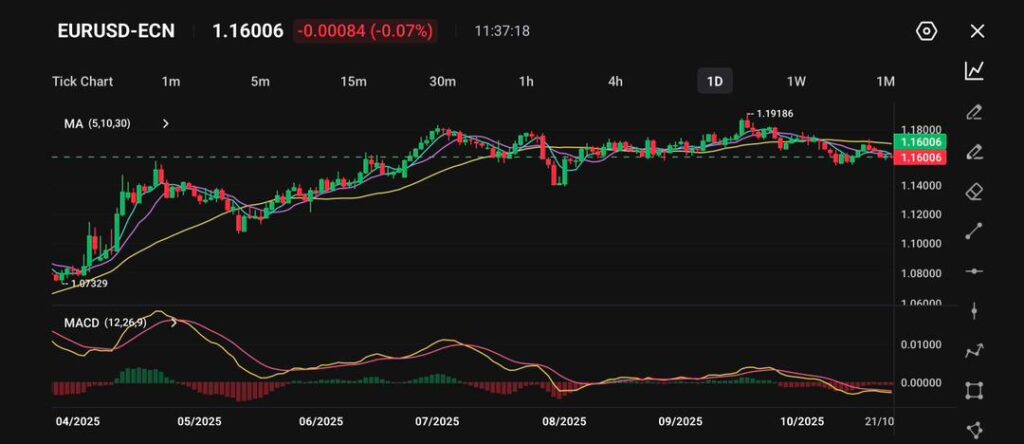
Key Points
- EUR/USD eased 0.07% to 1.1600, holding near the middle of its two-month range.
- Markets remain focused on Friday’s European PMI and U.S. CPI reports.
- Analysts expect the pair to stay range-bound in the short term.
The euro traded little changed around $1.16 on Thursday, consolidating within its recent range as traders awaited fresh catalysts from upcoming data releases.
With a quiet European calendar, sentiment was largely dictated by broader market risk appetite. The only notable release scheduled was the European Commission’s consumer confidence report, due later in the session.
Traders looked ahead to Friday’s Eurozone Purchasing Managers’ Surveys and delayed U.S. inflation data for directional cues.
Market Commentary
Our research desk believes the euro is likely to remain range-bound in the near term, tracking overall market sentiment.
The U.S. dollar was broadly steady, supported by cautious risk positioning and expectations that the Federal Reserve could maintain an easing bias into year-end.
Technical Analysis
The EUR/USD pair slipped slightly to 1.16006, marking a 0.07% decline as the euro continues to trade under mild downward pressure.
The move reflects ongoing dollar resilience and caution ahead of key U.S. economic data releases, with traders positioning defensively amid renewed speculation about the Federal Reserve’s policy trajectory.
From a technical perspective, the pair remains in a mild downtrend after failing to sustain gains above 1.1700 earlier this month.

The price currently hovers just below the short-term moving averages (5-, 10-, and 30-day MAs), which have flattened out, a signal of consolidation rather than a clear reversal. Immediate support is seen at 1.1570–1.1550, with further downside risk toward 1.1500 if that zone breaks.
On the upside, resistance stands near 1.1700, followed by the 1.1800 region that capped previous rallies.
The MACD indicator remains below the signal line, confirming that momentum still favours sellers. The histogram also stays in negative territory, though the bars are narrowing slightly — suggesting selling pressure may be easing as the pair stabilises.
Fundamentally, the euro remains constrained by subdued Eurozone growth and expectations that the European Central Bank (ECB) will maintain a cautious stance.
Meanwhile, the dollar continues to benefit from relative U.S. economic resilience and safe-haven demand. Traders are watching upcoming U.S. PMI and GDP figures for fresh direction, as stronger data could push the greenback higher.









